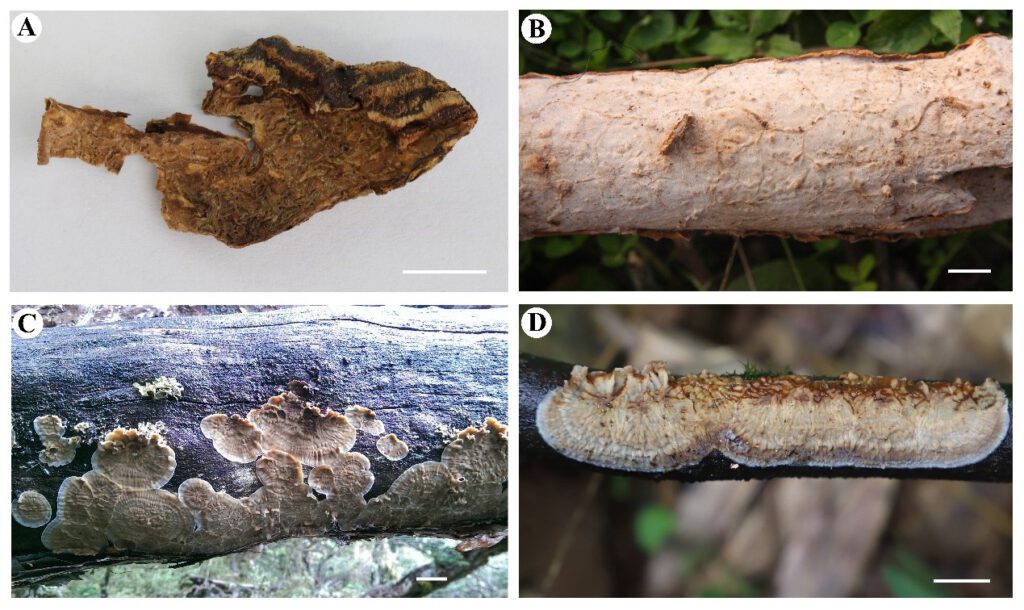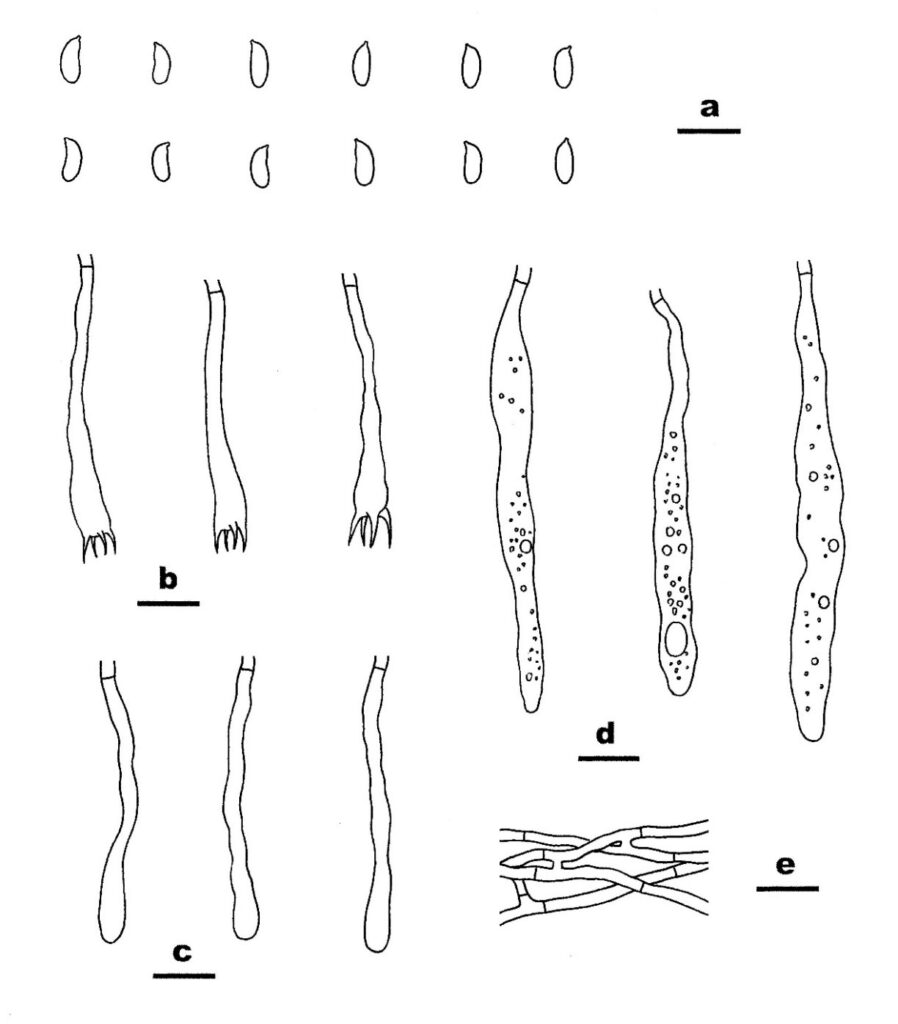Gelatinostereum phlebioides S.H. He, S.L. Liu & Y.C. Dai, sp. nov.
MycoBank number: MB; Index Fungorum number: IF; Facesoffungi number: FoF 10787;
Description
Sexual state: Fruiting body – Basidiomata annual, resupinate to effused-reflexed, adnate, separable, gelatinous, hygrophanous, soft when fresh, becoming ceraceous to cartilaginous, brittle after dry, up to 30 cm long, 5 cm wide, 500 µm thick. Pilei small, oftern radiately plicate; abhymenial surface glabrous, light brown, golden brown to dark brown, indistinctly zonate and sulcate. Hymenophore smooth, tuberculate to merulioid, greyish orange [5B(3–6)], brownish orange [5C(4–6)], light brown [5D(4–8)] to brown [5E(4–8)], slightly darkening in KOH, uncracked or densely cracked with age; margin determinate, abrupt, adnate or slight elevated and curved toward hymenophore, white when juvenile, slightly paler or concolorous with hymenophore when mature. Context brownish orange, with a compact and agglutinated texture, up to 0.4 mm thick.
Microscopic structures –Hyphal system dimitic; all hyphae without clamps. Subiculum distinct, with a compact texture, composed of tightly agglutinated and parallelly arranged hyphae; generative hyphae colorless, thin- to thick-walled with a wide lumen, smooth, rarely branched, moderately septate, 3–4.5 µm in diam. Skeletal hyphae colorless, distinctly thick-walled, smooth, unbranched, not septate, with walls swelling in KOH, 4–6 µm in diam. Subhymenium thickening with age; generative hyphae colorless, thin-walled, smooth, interwoven, agglutinated, 2–4 µm in diam. Gloeocystidia numerous, tubular, subclavate or subulate, colorless, thin-walled, smooth, often with liquid contents, mostly embedded, (35–) 60–130 × 7–12 (–14) µm. Hyphidia numerous, colorless, thin- to slightly thick-walled, smooth, 25–35 × 2–3.5 µm. Basidia clavate, colorless, thin-walled, smooth, with four sterigmata and a basal septum, 20–40 × 4–5.5 µm. Basidiospores cylindrical to suballantoid, colorless, thin-walled, smooth, amyloid, acyanophilous, (5.5–) 6–7.8 (–8.3) × 2–3 (–3.8) µm, L = 6.8 µm, W = 2.6 µm, Q = 2.6–2.7 (n = 90/3).
Asexual state: not observed.
Material examined: CHINA, Fujian Province, Wuyishan County, Wuyishan Nature Reserve, On dead branch of Rhododendron, 17 August 2016, He 4492 (BJFC 023933); Guizhou Province, Jiangkou County, Fanjingshan Nature Reserve, On fallen trunk of Rhododendron, 24 November 2014, Dai 14965 (BJFC 018078, holotype, isotype in BJM); Jiangxi Province, Lianping County, Jiulianshan Nature Reserve, On dead branch of Rhododendron, 14 August 2016, He 4383 (BJFC 023824); Yunnan Province, Jingdong County, Ailaoshan Nature Reserve, On dead branch of Rhododendron, 15 October 2013, He 1951 (BJFC 016419); Yulong County, Laojunshan Nature Reserve, On fallen trunk of Rhododendron, 1 September 2015, He 2918 (BJFC 021348); Fuyuan County, Shibalianshan Nature Reserve, on dead branch of Rhododendron, 19 November 2019, He 6340 (BJFC 033284).
Distribution: China
Sequence data: LSU: MW528940 (LROR/LR7)
Notes: Gelatinostereum phlebioides is the only species in the genus so far. It is similar to species of Stereum s.s., which, however, differs in non-gelatinous basidiomata and thick-walled skeletocystidia.

Fig. 7. Basidiomata of Gelatinostereum phlebioides. a Dai 14965 (BJFC 018078, holotype). b He 1951 (BJFC 016419). c He 2918 (BJFC 021348). d He 6340 (BJFC 033284). Scale bars: a–d = 1 cm.

Fig. 8. Microscopic structures of Gelatinostereum phlebioides. a Basidiospores. b Basidia. c Basidioles. d Gloeocystidia. e Generative hyphae. Scale bars: a–e = 10 µm.
